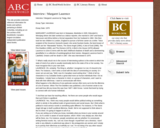
In this interview with Margaret Laurence in 1979, she talks of her early influences and her beliefs about writing.
- Subject:
- Arts
- English Language Arts
- Material Type:
- Primary Source
- Author:
- Alan Twigg
- Date Added:
- 08/07/2023

In this interview with Margaret Laurence in 1979, she talks of her early influences and her beliefs about writing.

This Bibliomania website provides full text for both the "complete version" and the "shorter version" of Oscar Wilde's poem "The Ballad of Reading Gaol." A brief introduction is provided with information on the context and meaning of the work as well as quotations ("each man kills the thing he loves").

A poster extolling the virtues of Thomas Edison's new phonograph is accompanied by text that explains the purpose of the poster and how it was made.

This lesson is a simulation of opening a bank. Students are assigned various roles to play within the banking business. Students learn about the role banks play in a market economy.
![Barbara Greenwood's Guide to - Writing For Children [PDF]](https://openspace.infohio.org/static/newdesign/images/materials/default-thumbnail-index.png)
Barbara Greenwood, a Canadian author of numerous historical fiction books for children, has written this thirty-page writing guide where she explains the process she goes through in constructing a story. She covers such key topics as character development, writing dialogue and descriptions, as well as the revision stages.

Site provides links to a wide variety of reference tools, including encyclopedias, dictionary, thesaurus, quotation books, and guides to English usage. L.11-12.1b Usage issues

Bartleby provides the full text for the following poems: "The Retreat", "Peace", "The Timber", and "Friends Departed".

Bartleby.com provides the full text to Robert's Rules of Order Revised (published 1915). The content is indexed by section.

Download and read Baruch Blumberg's Nobel Lecture entitled "Australia antigen and the biology of hepatitis B." This lecture, originally given December 13, 1976, is available in PDF format.

This Florida State University page includes an interactive java tutorial that explores the relationship between frequency, wavelength, and energy, and enables the visitor to adjust the intensity of the radiation and to set the wave into motion. There is also a discussion on electromagnetic waves that accompany the tutorial.

In this site from the physics classroom, kinetic energy is defined and discussed. The equation for its computation is also given and practice computation problems are given.

This online lesson plan is a fun way to wrap up a unit on animals! Student create their own shape book, then fill it with information about an animal they've researched. This site also provides adaptations and resources. (To access this lesson plan, you must register with Crayola.com. Registration is free and takes only a few moments to complete.)

A storybook about the bedtime routine of a young child. Includes audio readaloud feature in 17 additional languages, although text is in English.

This beautiful online edition of the Lewis Carroll classic is written in large text for easy legibility, and includes illustrations from eleven different versions of the story. It also includes background information on the writing of the story and on the illustrators.

This tutorial for students new to algebra provides explanations, definitions, examples, and practice problems. The practice tests cover topics such as real numbers, fractions, equations, graphing, and exponents.

A tutorial as an introduction to polynomials. Basic terminology and simple algebraic manipulations. Offers discussions and practice exercises with answers and explanations.

A tutorial to understand the three central tendencies and how to find them, as well as the standard deviation of values. Offers a discussion and practice problems.

A tutorial with step-by-step examples to learn how to divide two polynomials. The site offers a list of steps to successfully divide polynomials using long division.

A tutorial on how to graph a linear inequality in two variables. The tutorial offers step-by-step instruction and examples of how to graph linear inequalities.

A guide to solving problems involving numbers, rectangles, and angles. You'll learn how to employ Polya's four steps: understand the problem, devise a plan, carry out the plan, and look back.